Golf course
This article needs additional citations for verification. (September 2011) |
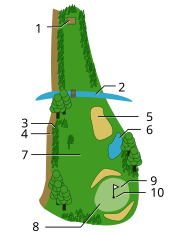
A golf course comprises a series of holes, each consisting of a teeing ground, a fairway, the rough and other hazards, and a green with a flagstick ("pin") and hole ("cup"), all designed for the game of golf. A standard round of golf consists of playing eighteen holes, and most golf courses therefore have this number of holes.[1] Some, however, only have nine holes, and the course is played twice per round. Other courses have twenty-seven or thirty-six holes and players choose two groups of nine holes each, providing novelty, and also for maintenance reasons. Additionally, par-3 courses also exist, consisting of nine or eighteen holes, all of which are par 3 (the number of strokes considered standard for a scratch golfer). Many older golf courses, often coastal, are golf links, which are a different style from the others. Non-municipal courses usually include a golf club based at the course, which generally provides a pro shop.
Teeing area

The first section of every hole consists of the teeing ground, or tee-box. There is typically more than one available box where a player places his ball, each one a different distance from the hole. The teeing ground is generally as level as feasible, and most are slightly raised from the surrounding fairway. The most common tee areas, in increasing order of length from the hole, are the ladies' tee, the men's tee, and the championship tee. Other tee-boxes commonly designated include the junior tee, closer to the hole than the ladies' tee, and the senior tee, generally between the ladies' tee and the men's tee. In tournaments, golfers generally tee off from the box one level further from the "normal" box for their class (men use the championship tee, ladies use the senior or men's tee, and juniors use the ladies' tee).
Each tee box has two markers showing the bounds of the legal tee area. The teeing area spans the distance between the markers, and extends two-club lengths behind the markers. A golfer may play the ball from outside the teeing area, but the ball itself must be struck from within the area.[2] A golfer may place his ball directly on the surface of the teeing ground (called hitting it "off the deck"), though the ball may be supported by a manufactured tee (limited to a height of four inches), or by any natural substance, such as sand placed on the teeing surface.
Fairway and rough
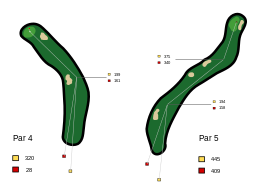
After the first shot from the tee ("teeing off"), the player hits the ball from where it came to rest toward the green. The area between the tee box and the putting green where the grass is cut even and short is called the fairway and is generally the most advantageous area from which to hit. The area between the fairway and the out-of-bounds markers, and also between the fairway and the green, is the rough, the grass of which is cut higher than that of the fairway and which is generally a disadvantageous area from which to hit. On par-3 holes, the player is expected to be able to drive the ball to the green on the first shot from the tee box. On holes longer than par 3, players are expected to require at least one additional shot made from the fairway or the rough.
While many holes are designed with a direct line-of-sight from the teeing ground to the green, a hole may bend either to the left or to the right. This is called a "dogleg", in reference to the similarity to a dog's ankle. The hole is called a "dogleg left" if the hole angles leftwards, and a "dogleg right" if the hole angles rightwards. A hole's direction may bend twice, which is called a "double dogleg".
Just as there are good-quality grasses for putting greens, there are good-quality grasses for the fairway and rough. The quality of grass influences the roll of the ball as well as the ability of the player to "take a divot" (effectively, the ability to hit down into the ball, hitting the ball first, then hitting the turf and removing a portion of it as the club continues its arc). Fairways on prestigious tours, like the PGA Tour, are cut low. Mowing heights influence the play of the course. For example, the grass heights at U.S. Open events are alternated from one hole to the next in order to make the course more difficult. One example of this is the infamous roughs at U.S. Opens, which are often 3-5 inches high, depending on how close to the fairway or green the section of grass will be. This makes it difficult for a player to recover after a bad shot.
Some variants of grass used for fairways and roughs are bent grass, Tifway 419 Bermuda grass,[3] rye grass, Kentucky bluegrass, and Zoysiagrass. As in putting-green grass types, not every grass type works equally well in all climate types.
Hazards
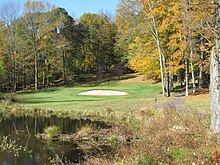
Holes often include hazards, which may be of three types: (1) water hazards, such as ponds, lakes, and rivers, (2) man-made hazards, such as bunkers, and (3) natural hazards, such as dense vegetation. Special rules apply to playing a ball that falls in a hazard. For example, a player may not touch the ground or water with his club before playing the ball, not even for a practice swing. A ball in any hazard may be played as it lies without penalty. If it cannot be played from the hazard, the ball may be hit from another location, generally with a penalty of one stroke. The Rules of Golf specify exactly the point from which the ball may be played outside a hazard. Bunkers ("sand traps") are areas, shallow or deep, filled with sand and generally incorporating a raised lip or barrier, from which the ball is more difficult to play than from grass. As in any hazard, a ball in a bunker must be played without touching the sand with the club except during the stroke.
Putting green
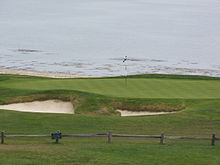
To "putt" is to play a stroke on the defined putting surface. This stroke ordinarily is played on the green with a putter (a club with very low loft) such that the ball does not leave the ground. Once on the green, the ball is putted (struck with the eponymous flat-faced club to roll it along the ground) toward the hole until the ball falls into the cup.
The grass of the putting green (more commonly just "green") is cut very short so that a ball can roll for a long distance. The most common types of greens for cold winter, but warmer summer regions (i.e., not extremely warm, as in the Southern and Southwestern United States) are bent grass greens. A green may consist of a thin carpet so that bad weather is not allowed to become a serious factor in maintaining the course. These are considered the best greens because they may be cut to an extremely low height, and because they may be grown from seed. Bent grass does not have grain, which makes it superior as a putting surface. However, bent grass may become infested with poa annua, a costly and time-consuming weed. Augusta National is one of many golf courses to use this type of green. The original design of Augusta National did not include bent grass greens, but in the 1980s the controversial decision was made to convert the greens from Bermuda to bent grass. This has affected the speed and playing of Augusta National. [citation needed] Many other golf courses subsequently made the decision to change from Bermuda to bent grass when they observed increased business at courses that had already changed over.[citation needed] Another type of grass common for greens is TifDwarf Hybrid Bermuda (other variants exist, but TifDwarf is one of the most common), or simply Bermuda grass. Bermuda is more common in regions that have very warm summers and mild winters, such as the Southern and Southwestern United States. Red Bridge Golf Course was the first course in North Carolina to utilize a special Bermuda called Mini Verde. A green is generally established from sod which has had the soil washed off of it (to avoid soil compatibility problems) and which is then laid tightly over the green, then rolled and topdressed with fine sand. Another common and more economical approach for establishing a putting green is to introduce hybrid Bermuda spriggs (the stolon of the grass which are raked out at the sod farm), which are laid out on the green. The best greens are always established vegetatively and never from seed.
Two downside factors of Bermuda greens are cost of maintenance, and also the existence of grain (the growth direction of the blades of grass), which affects the ball's roll and which is called "the grain of the green." The slope or break of the green also affects the roll of the ball. The hole, or cup, is always found within the green and must have a diameter of 108 millimeters (4.25 in) and a depth of at least 10 centimeters (3.94 in). Its position on the green is not fixed and typically is changed daily by a greenskeeper in order to prevent excessive localized wear and damage to the turf. The hole has a flag on a metal pole positioned in it so that it may be seen from a distance, but not necessarily from the tee. This location marker is officially called the "flagstick" but is also commonly referred to as the "pin.".
Putting greens are not all of the same quality. The finest-quality greens are well-kept so that a ball will roll smoothly over the closely mowed grass. Excess water can be removed from a putting green using a machine called a water hog. Golfers describe a green as fast if a light stroke on the ball makes it roll a long distance; conversely, on a slow green a stronger stroke is necessary to roll the ball the same distance. The exact speed of a green can be determined with a stimp meter. By collecting sample measurements, golf courses can be compared in terms of average green speed. It is, however, illegal by the Rules of Golf to test the speed of a green while playing by rolling a ball on it, or by feeling or rubbing the green.
Par
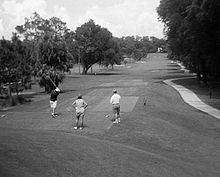
Most golf courses have only par-3, -4, and -5 holes, though some courses include par-6 holes. (The Ananti CC and the Satsuki golf course in Sano, Japan are the only courses with par 7 holes.)[citation needed] Typical distances for the various holes from standard tees are as follows.
Men
- Par 3 – 250 yards (230 m) and below
- Par 4 – 251–450 yards (230–411 m)
- Par 5 – 451–690 yards (412–631 m)
- Par 6 – 691 yards (632 m) or more
Women
- Par 3 – 210 yards (190 m) and below
- Par 4 – 211–400 yards (193–366 m)
- Par 5 – 401–575 yards (367–526 m)
- Par 6 – 575 yards (526 m) or more
Harder or easier courses may have longer- or shorter-distance holes, respectively. Terrain can also be a factor, so that a long downhill hole might be rated par 4, but a shorter uphill or notably treacherous hole might be rated par 5. Professional tournament players will often encounter longer par-3 holes, up to 290 yards (270 m), and longer par-4 holes, up to 520 yards (480 m).
Other areas
Some areas of the course are designated "ground under repair" (GUR), where greenskeepers are making repairs or where the course has been damaged. A ball coming to rest in this area may be lifted, then played from outside the GUR without penalty. Certain man-made objects on the course are defined as obstructions (e.g., distance posts or gardens), and specific rules determine how a golfer may proceed when his play is impeded by them.
Driving range
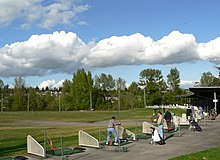
Often, a golf course will include among its facilities a practice range or driving range, usually with practice greens, bunkers, and driving areas. Markers showing distances are usually included on a practice range for the golfer's information. There may even be a practice course (often shorter and easier to play than a full-scale course), where players may measure the distance they can obtain with a specific club, or in order to improve their swing technique.
Design
Although a specialty within landscape design or landscape architecture, golf course architecture is considered a separate field of study. Some golf course architects become celebrities in their own right. The field is partially represented by the American Society of Golf Course Architects, the European Institute of Golf Course Architects, and the Society of Australian Golf Course Architects, though many of the finest golf course architects in the world choose not to become members of any such group, as associations of architects are not government-sanctioned licensing bodies, but private groups.
While golf courses often follow the original landscape, some modification is unavoidable. This is increasingly the case as new courses are more likely to be sited on less optimal land. Bunkers and sand traps are almost always artificial, although other hazards may be natural.
The layout of a fairway follows certain traditional principles, such as the number of holes (nine and eighteen being most common), their par values, and the number of holes of each par value per course. It is also preferable to arrange greens to be close to the tee box of the next playable hole, to minimize travel distance while playing a round, and to vary the mix of shorter and longer holes. Combined with the need to package all the fairways within what is frequently a compact square or rectangular plot of land, the fairways of a course tend to form an oppositional tiling pattern. In complex areas, two holes may even share a single tee box. It is also common for separate tee-off points to be positioned for men, women, and amateurs, each one respectively lying closer to the green. Eighteen-hole courses are traditionally broken down into a "front 9" (holes 1-9) and a "back 9" (holes 10-18). On older courses (especially links courses, like the Old Course at St. Andrews), the holes may be laid out in one long loop, beginning and ending at the clubhouse, and thus the front 9 is referred to on the scorecard as "out" (heading out away from clubhouse) and the back 9 as "in" (heading back in toward the clubhouse). More recent courses (and especially inland courses) tend to be designed with the front 9 and the back 9 each constituting a separate loop beginning and ending at the clubhouse. This is partly for the convenience of the players and the club, as then it is easier to play just a 9-hole round, if preferred, or stop at the clubhouse for a snack between the front 9 and the back 9.
A successful design is as visually pleasing as it is playable. With golf being a form of outdoor recreation, the strong designer is an adept student of natural landscaping who understands the aesthetic cohesion of vegetation, water bodies, paths, grasses, stonework, and woodwork, among other elements.
Executive golf course
A special design of golf course is the "executive" course (also known as a "par-3" course). This type differs from the standard course in that the majority of holes are par-3, with one or two par-4 holes added and sometimes (though rarely) a par-5-hole. The executive course is intended for beginners or older golfers and for those who lack the time to play a round on a standard-length course.
Environmental impact
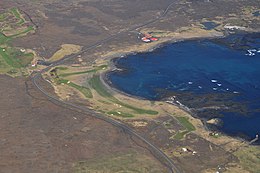
Environmental concerns over the use of land for golf courses have grown over the past fifty years. Specific issues include the amount of water required for irrigation and the use of chemical pesticides and fertilizers in maintenance, as well as the destruction of wetlands and other environmentally important areas during construction. The United Nations estimates that, worldwide, golf courses consume about 2.5 billion gallons/9.5 billion liters of water per day. Many golf courses are now irrigated with non-potable water and rainwater. In 1988, the U.S. Environmental Protection Agency prohibited the use of Diazinon on golf courses and sod farms because of its negative impact on bird species.
These, along with health and cost concerns, have led to research into more environmentally sound practices and turf grasses. The golf course superintendent is often trained in the uses of these practices and grasses. This has led to significant reduction in the amount of both water and chemicals on courses. The turf on golf courses is an excellent filter for water and has been used in communities to cleanse grey water, such as incorporating into bioswales.
Environmentalists and other activists continue to oppose the building of new golf courses for environmental reasons, as they may impede corridors for migrating animals and damage sanctuaries for birds and other wildlife, though some courses have become havens for native and non-native creatures.
A result of modern equipment is that today's players can hit the ball much farther than previously. As a result, because of demand from course customers who possess this enhanced equipment, and also out of an expressed concern for safety, golf course architects have had to lengthen and widen golf courses. Where a 7,000-yard course used to be a great rarity, courses measuring 7,500-yards are now not uncommon, and courses of 8,000-yards are being contemplated. All this has led to a ten-percent increase in the acreage required to build a typical course. At the same time, water restrictions established by communities have forced courses to limit the amount of maintained turf grass. While most modern 18-hole golf courses occupy as much as 60 hectares (150 acres) of land, the average course has 30 Ha (75 acres) of maintained turf. (Sources include the National Golf Foundation and the Golf Course Superintendents Association of America GCSAA.)
Golf courses can be built on sandy areas along coasts, on abandoned farms, among strip mines and quarries, and in deserts and forests. Many Western countries have instituted environmental restrictions on where and how courses are allowed to be built.[4][5]
In some parts of the world, attempts to build courses and resorts have led to protests, vandalism, and violence. Golf is perceived by some as an elitist activity, and thus golf courses become a target for popular opposition. Resisting golf tourism and golf's expansion has become an objective of some land-reform movements, especially in the Philippines and Indonesia.
In the Bahamas, opposition to golf developments has become a national issue. Residents of Great Guana Cay and Bimini, for example, are engaged in legal and political opposition to golf developments on their islands, for fear the golf courses will destroy the nutrient-poor balance on which their coral reef and mangrove systems depend.
In Saudi Arabia and elsewhere in arid regions, golf courses have been constructed on nothing more than oil-covered sand. Players may use a roller on the "greens" to smooth the intended path before putting. A course in Coober Pedy, Australia, consists of nine holes dug into mounds of sand, diesel fuel, and oil, with no grass appearing anywhere on the course. Players carry a small piece of astroturf from which they tee the ball. In New Zealand, it is not uncommon for rural courses to have greens fenced off and sheep grazing the fairways. At the 125-year-old Royal Colombo Golf Club in Sri Lanka, steam trains from the Kelani Valley railway run through the course at the 6th hole.
Extreme golf
Extreme golf is a variation of the game played on environmentally sustainable alternatives to traditional courses. A cross between hiking and golf, the course layout exposes players to a wide range of natural obstacles and challenging terrain.
Based on the growing popularity of the U.X. Open Alternative Golf Tournament, the extreme golf course features un-mowed meadows and forest instead of fairways, with "goals" scored on temporary greens (a circle 20 feet, or 6 metres, in diameter).[6]
References
- ^ "Why does a golf course have 18 eighteen holes?", www.ScottishGolfHistory.net, 2003-2007, webpage: SGH18.
- ^ Rules of Golf and the Rules of Amateur Status 2008–2011 (PDF). St Andrews, Fife, Scotland: The Royal and Ancient Golf Club of St Andrews and United States Golf Association. September 2007. p. 67. Retrieved 16 September 2008.
- ^ "Tifway 419 Bermuda". Phillip Jennings Turf Farms. Retrieved 2 March 2009.
- ^ Hogan, C.M. (1992). Environmental Impact Report for the Pebble Beach Properties project by Del Monte Forest. Earth Metrics Inc., Prepared for the city of Monterey and State of California Clearinghouse.
{{cite book}}: Unknown parameter|coauthors=ignored (|author=suggested) (help) - ^ U.S. Federal Register: 2 August 1995 (Volume 60, Number 148, Pages 39326-39337)
- ^ "Extreme golf courses". Retrieved 7 November 2007.
External links
- Course Rating Primer at the website of the United States Golf Association
- Golf for Beginners FAQ
